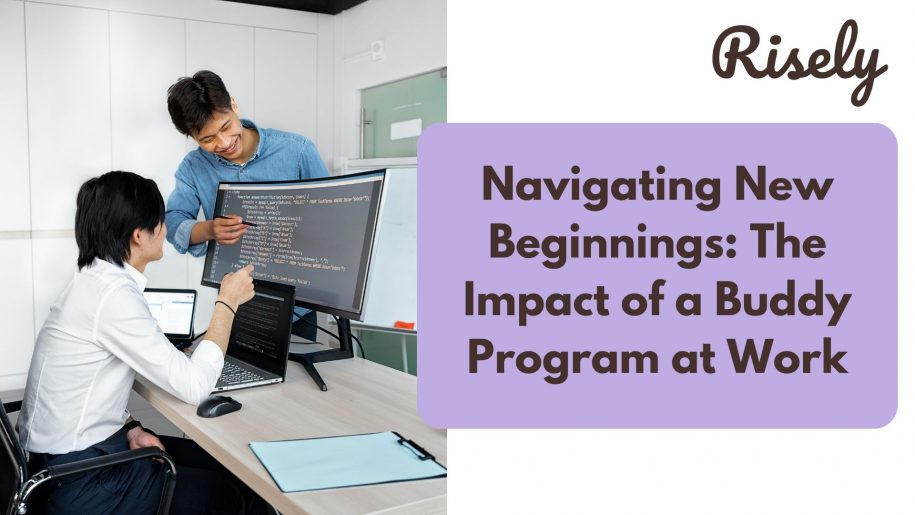Navigating New Beginnings: The Impact of a Buddy Program at Work
As organizations strive to create more inclusive and supportive work environments, innovative approaches to employee onboarding have gained prominence. One such approach that has gained traction is the “Buddy Program.” This program goes beyond traditional methods by pairing new hires with experienced employees, or “buddies,” to facilitate a smoother transition into the company culture and operations. In this blog, we delve into buddy programs, exploring their objectives, benefits, and strategies for successful implementation.What is a buddy program at work?
A buddy program at work is a structured initiative where new employees, often referred to as “buddies,” are paired up with experienced colleagues or mentors. The purpose of this program is to provide support, guidance, and a sense of camaraderie to the new hires during their initial days or weeks in the organization. Buddies help newcomers integrate into the company culture, understand job responsibilities, and navigate the workplace more smoothly. This program aims to enhance employee engagement, boost retention rates, and create a positive onboarding experience for new hires.What is the objective of a buddy program at work?
The primary objective of a buddy program at work is to facilitate the smooth integration and onboarding of new employees into the organization. This is achieved through various goals and outcomes:- Knowledge transfer: By sharing their expertise and insights, buddies help new employees understand their job roles, responsibilities, and tasks more effectively.
- Cultural integration: Buddies familiarize new hires with the company culture, values, norms, and expectations, helping them feel more comfortable and aligned with the organization’s ethos.
- Accelerated learning: Buddies assist new employees in getting up to speed quickly by providing guidance, resources, and tips that may not be readily available through formal training.
- Relationship building: The buddy system helps new hires establish relationships with colleagues, fostering a sense of camaraderie and belonging within the team.
- Reduced stress: Having a buddy to turn to for questions and support can alleviate the stress and anxiety that often accompany the initial stages of a new job.
- Increased engagement: When new hires feel supported and valued, they are more likely to engage with their work and remain committed to the organization.
Benefits of buddy program at work
A buddy program at work offers numerous benefits for both new hires and the organization as a whole. Some of the key advantages include:- Smooth onboarding: Buddies help new employees acclimate to their roles and the company culture more quickly, reducing the time it takes for them to become productive contributors.
- Enhanced engagement: New hires who feel supported and connected through a buddy program are more likely to feel engaged and committed to their work and the organization.
- Faster learning curve: Buddies share their knowledge and experience, helping new employees learn job tasks, procedures, and company processes more efficiently.
- Improved confidence: Buddies offer guidance and reassurance, boosting the confidence of new employees as they navigate their roles and responsibilities.
- Cultural integration: Buddies help new hires understand and adapt to the company’s values, norms, and practices, facilitating a smoother cultural integration.
- Positive workplace experience: A buddy program fosters a sense of camaraderie and belonging, leading to a more positive overall experience for new hires.
- Higher retention rates: Effective onboarding through buddy programs can increase retention rates, as new employees feel supported and valued.
Other Interesting Reads
How to create a buddy program at your workplace?
Creating a successful buddy program at your workplace involves careful planning, implementation, and ongoing support. Here’s a step-by-step guide to help you establish a buddy program: 1. Define objectives: Determine the goals of your buddy program. Are you aiming to improve onboarding, enhance employee engagement, or foster knowledge sharing? Clearly define the purpose and expected outcomes. 2. Identify participants: Select experienced employees willing to guide and support new hires. Consider approachable, knowledgeable individuals who embody the company’s values. 3. Develop guidelines: Create clear guidelines for buddies and new employees. Outline each participant’s roles, responsibilities, and expectations in the buddy program. 4. Pair buddies and new hires: Match buddies with new hires based on department, role, personality, and shared interests. Ensure the pairing is mutually beneficial. 5. Provide training: Train buddies on their responsibilities, including how to welcome new hires, provide guidance, answer questions, and address concerns. 6. Establish a timeline: Determine the duration of the buddy program. It can vary based on your organization’s needs, but an initial period of 1 to 3 months is common. 7. Facilitate introductions: Organize an official introduction between buddies and new employees. This can be a formal meeting or an informal social gathering to break the ice. 8. Monitor progress: Regularly check in with buddies and new employees to ensure the program runs smoothly. Address any issues or concerns promptly. 9. Gather feedback: Gather feedback from buddies and new hires to identify strengths and areas for improvement in the buddy program. 10. Recognize and reward: Acknowledge the efforts of buddies and recognize their contributions to the program. This can include shout-outs, certificates, or small rewards. 11. Continuous improvement: Use the feedback collected to refine the buddy program and make necessary adjustments for future iterations. 12. Evaluate results: Periodically assess the impact of the buddy program on new employee integration, engagement, and overall job satisfaction. A well-designed buddy program can significantly enhance the onboarding experience, foster a sense of belonging, and accelerate new employees’ integration into the workplace culture.Conclusion
In modern workplaces, the significance of a well-structured onboarding process cannot be overstated. As we conclude our blog on buddy programs, it becomes evident that these initiatives offer more than just a warm welcome to new employees. They embody a collaboration, empathy, and growth philosophy that transforms the onboarding journey into a shared experience. By harnessing the potential of buddy programs, organizations can create a culture where newcomers feel valued, supported, and equipped to excel from day one. The impact goes beyond the individual; it ripples through teams, departments, and the organization, contributing to increased engagement, higher retention rates, and a thriving work environment.Gain the skills to effectively set goals for the buddy program at work.
Take the free goal setting assessment to navigate challenging situations at work.
Frequently Asked Questions
What is a Buddy Program at Work?
A buddy program at work involves pairing new employees (buddies) with experienced colleagues to assist them during their onboarding journey. The buddies offer guidance, support, and a friendly connection to help newcomers integrate into the company.
How to Create a Buddy Program at Work?
To create a buddy program, follow these steps:
Define the objectives and goals of the program.
Identify potential buddies who are experienced, approachable, and aligned with the program’s purpose.
Train buddies on their roles and responsibilities, emphasizing mentorship and support.
Assign buddies to new hires and introduce them during the onboarding process.
Encourage open communication and regular check-ins between buddies and newcomers.
Evaluate the program’s effectiveness through feedback and continuous improvement.
Define the objectives and goals of the program.
Identify potential buddies who are experienced, approachable, and aligned with the program’s purpose.
Train buddies on their roles and responsibilities, emphasizing mentorship and support.
Assign buddies to new hires and introduce them during the onboarding process.
Encourage open communication and regular check-ins between buddies and newcomers.
Evaluate the program’s effectiveness through feedback and continuous improvement.
What’s the objective of a buddy program?
The main objective of a buddy program is to provide a smoother transition for new employees into the workplace. It aims to help newcomers feel welcome, supported, and empowered to adapt quickly to the company’s culture, processes, and expectations.
Other Related Blogs
Performance Management Training: Empowering Managers To Manage Better
Performance Management Training: Empowering Managers To Manage Better Remember that feeling of dread when you knew performance review season was rolling around? Yeah, us, too. For many employees, performance reviews…
Manager Development Goals And How To Reach Them: Opportunities And Areas To Focus On
Manager Development Goals And How To Reach Them: Opportunities And Areas To Focus On You’ve meticulously crafted a development program for your high-potential employees, but their managers just aren’t on…
Leader Competence: The Cornerstone of Effective Leadership Development
Leader Competence: The Cornerstone of Effective Leadership Development Imagine you’re leading a talented team, but somehow, projects are stalling, and motivation seems slipping. You see the potential in your people,…
Confused by L&D Metrics? Here’s How to Focus on What Matters
Confused by L&D Metrics? Here’s How to Focus on What Matters You’ve undoubtedly witnessed companies celebrating a record number of employees completing leadership training programs. Champagne toasts erupt, press releases…


